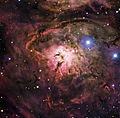Fail:Lagoon Nebula.jpg

Necen ezikacundan suruz': 610 × 599 piksel'ad. Toine laskendad: 244 × 240 piksel'ad | 489 × 480 piksel'ad | 782 × 768 piksel'ad | 1043 × 1024 piksel'ad | 1841 × 1808 piksel'ad.
Originaline fail (1841 × 1808 piksel'ad, failan suruz': 2,92 mb, MIME-tip: image/jpeg)
Failan istorii
Paina päiväle/aigale, miše nägištada, mitte fail oli sil aigal.
| Päiv/Aig | Kuvaine | Suruded | Kävutai | Kirjutez | |
|---|---|---|---|---|---|
| nügüdläine | 4. Keväz’ku 2014, kell 03:20 |  | 1841 × 1808 (2,92 mb) | Lmbuga | Putting the nebula in the center of the image |
| 9. Eloku 2012, kell 10:48 |  | 2027 × 2064 (1,59 mb) | Fabian RRRR | higher resolution | |
| 22. Sulaku 2010, kell 10:32 |  | 1280 × 1303 (317 kb) | EricHS211 | {{Information |Description={{en|1=Infrared view of the Cat’s Paw Nebula (NGC 6334) taken by VISTA. NGC 6334 is a vast region of star formation about 5500 light-years from Earth in the constellation of Scorpius. The whole gas cloud is about 50 light-year |
Failan kävutamine
Nece 2 lehtpoled kävutaba necidä failad:
Failan leved kävutamine
Nene toižed wiki-lehtpoled kävutaba necidä failad:
- Kävutamine ady.wikipedia.org
- Kävutamine alt.wikipedia.org
- Kävutamine av.wikipedia.org
- Kävutamine bn.wikipedia.org
- Kävutamine cs.wikipedia.org
- Kävutamine cv.wikipedia.org
- Kävutamine de.wikipedia.org
- Kävutamine en.wikipedia.org
- Kävutamine et.wikipedia.org
- Kävutamine fr.wikipedia.org
- Kävutamine hu.wikipedia.org
- Kävutamine kaa.wikipedia.org
- Kävutamine kk.wikipedia.org
- Kävutamine koi.wikipedia.org
- Kävutamine ko.wikipedia.org
- Kävutamine kv.wikipedia.org
- Kävutamine lez.wikipedia.org
- Kävutamine mdf.wikipedia.org
- Kävutamine mg.wikipedia.org
- Kävutamine mk.wikipedia.org
- Kävutamine mrj.wikipedia.org
- Kävutamine olo.wikipedia.org
- Kävutamine os.wikipedia.org
- Kävutamine pl.wikipedia.org
- Kävutamine pt.wikipedia.org
- Kävutamine ru.wikipedia.org
- Kävutamine sah.wikipedia.org
- Kävutamine sh.wikipedia.org
- Kävutamine sk.wikipedia.org
Kaculevenzoitud kävutamine neciš failas.


